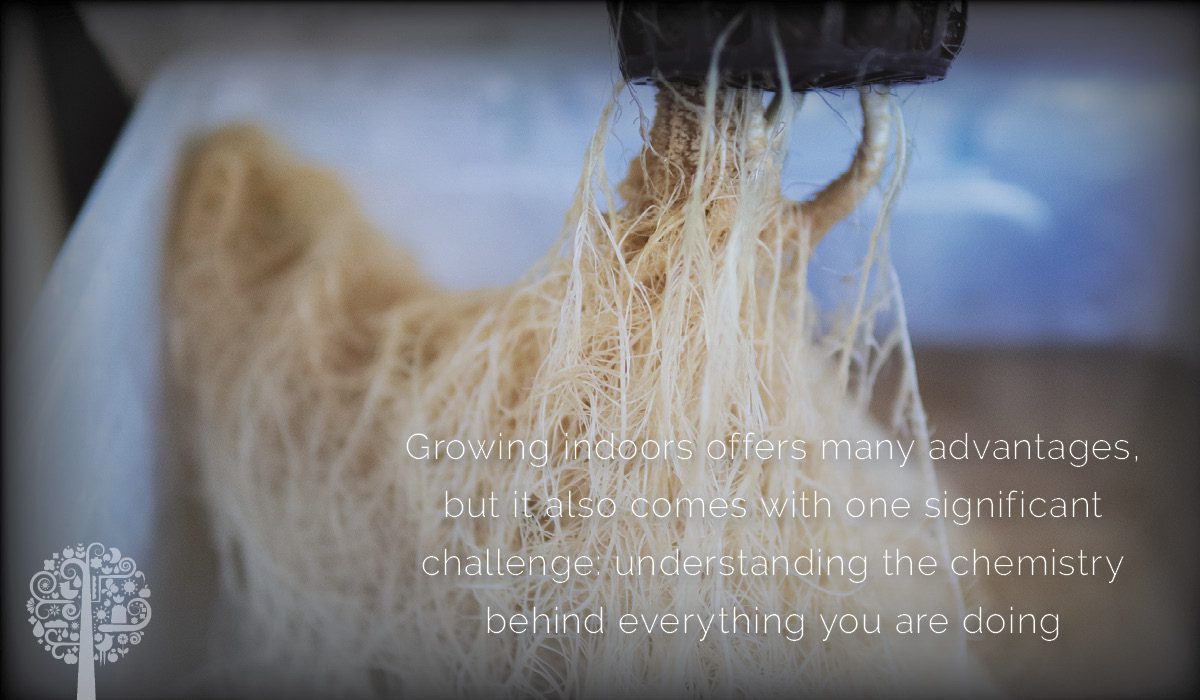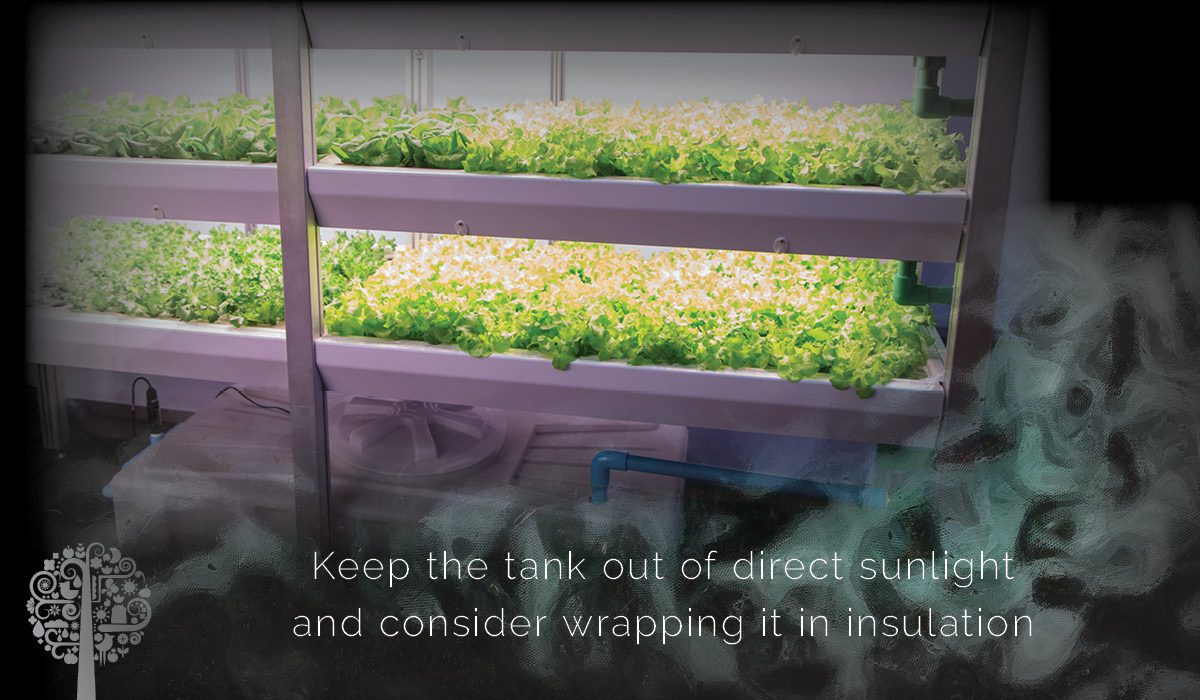An indoor garden’s success largely depends on the environment, with the nutrient feed being an integral part. The plant’s nutrients are a complex combination of chemical elements that must be prepared correctly. If great care is not taken, the substance can be something very different from what it once was. Growing indoors offers many advantages, but it also comes with one significant challenge: understanding the chemistry behind everything you are doing.
A Grow Room Story
Let’s say you are mixing a nutrient feed for a plant that requires an optimum pH range of between 5.5-6.5 and an EC of between 1.2-2.0. After adding the selected nutrients to clean water in the nutrient tank, you measure the pH, and it is in the range of 5.5, and your EC is around 1.4. Perfect!

A day later, you return to check your tank and find that the pH has risen to 7.5, which is no longer in the plant’s optimum range. The EC will also have changed, falling to the low end of the optimum range or out of it; the feed is now weaker. At this point, small rocks will have also formed at the bottom of the tank. How did they get there?
Why Did This Happen?
This change is the result of naturally occurring chemical exchanges and reactions. The water source alone can cause a pH fluctuation. All sources of water will contain some level of dissolved CO2, known as carbonic acid. Water from a household tap will have higher levels than most due to the bubbling and frothing in the plumbing system.
The change of CO2 into carbonic acid is a reversible reaction, meaning that CO2 can dissolve into and evaporate out of the water at will, affecting the overall pH and EC. While solids are more soluble at higher temperatures, the same is true for gases when colder. When water comes out of the tap, it is cold at around 10°C and full of carbonic acid. However, as the water warms to room temperature or above, the carbonic acid changes back into CO2. It evaporates along with other gases, such as dissolved oxygen and chlorine, reducing the tank’s acidity. This causes the pH to rise and the EC to fall.
Leaving tap water to stand for 24 hours stabilizes the temperature and pH. This can help matters in the short term but is not enough to ensure the pH remains stable in the long term. If you do not take action every time the temperature fluctuates by more than a few degrees, you will be adding or losing carbonic acid from your water and changing the pH and EC.
Smaller tanks and reservoirs heat up and cool down much faster than larger ones. Generally, nutrients are more stable in a large tank, and factors such as temperature, pH levels, and EC are much easier to manage.
The presence of algae and bacteria in the tank can also affect pH and EC levels. Lackadaisical cleaning regimes between tank changes and exposure to light or higher temperatures encourage organic matter such as algae and bacteria. When the two come together, irregular fluctuations occur as algae consume carbonic acid in the water. The pH will rise, and bacteria will release acids into the tank, causing pH to drop.
Precipitation
When it comes to looking at the solids or sediment lurking at the bottom of the tank, this can be explained as precipitation and can be caused by pH fluctuations. At the same time, the deposit can also cause pH fluctuations.
Precipitation is an irreversible chemical reaction where a liquid turns into a solid. In this case, the liquid is the nutrient mix, and the solids are the crystallized lumps at the bottom of the tank or reservoir. Not all sediments will be noticeable, however. Some are so fine that they remain suspended in the liquid and invisible to the naked eye.
A pH of more than six can start to affect the dissolvability of many nutrients. If the pH is already too high or too low, this can contribute to individual nutrient precipitation. In this instance, a chemical reaction occurs where one nutrient element reacts badly with the high pH, forms a solid, and becomes impossible for the plant to take up.
Incorrect or careless dosing when mixing feed and the mismanagement of the tank’s temperature will also lead to precipitation in the tank. In this situation, a chemical reaction occurs between two or more of the elements causing solids to form and rendering them insoluble to the plant.
Precipitation may be a consequence of too high or low pH, but it can also be a contributing factor to the problem of fluctuating pH. When specific elements are made unavailable to the plant, the tank’s environment changes. The acidity or alkalinity of what remains, along with the number of available nutrient salts, will both be different, exacerbating the fluctuation in pH and EC. At this point, precipitation will likely continue to occur as the conditions in the tank evolve.
Achieving A Perfect Environment
The water source is the first element needing attention. If using tap water, invest in a RO water filter, which will remove almost all impurities. RO water is purified using osmotic pressure with a membrane and is much more efficient at removing contaminants than a generic water filter.
Bubbling the water is a good idea, as this increases dissolved oxygen levels and keeps the mixture fresh and cool, thus deterring the growth of algae and bacteria. An airline also encourages dispersing all the nutrient elements in the water, keeping them moving and warding off any possible precipitation.
A light-proof tank is essential to prevent the growth of algae. Algae need light, as they use photosynthesis to grow and reproduce. Keep the tank out of direct sunlight and consider wrapping it in insulation. This will also help control temperature. Ideally, store the nutrient mixture at 18-23°c. Direct light will heat the feed, resulting in EC and pH fluctuations.
Place the tank in a cool, dark place. Keep the nutrient cool by insulating it and using an air conditioner or fan in the surrounding area. Keep in mind that cold temperatures can be just as damaging to the tank’s environment. If too chilly, consider moving the tank somewhere warmer, keeping it off the floor, insulating it, or turning the heat on.
Avoiding Precipitation
To avoid precipitation of nutrients, look after the bottles of concentrate. Keep them in a cool, dark place between 10-19°C. Precipitation can occur within the bottles of concentrate before ever being opened if stored incorrectly.
When mixing nutrients, follow the instructions on the bottle and use clean equipment. Never mix nutrients unless it is into a body of water. Some nutrients do not mix well in a concentrated form, and a chemical reaction can occur, which changes their nutritional composition and affects their bioavailability.

Add nutrients gradually and stir well to ensure even dispersal. Precipitation often occurs when concentrated nutrients are mixed together too quickly. If adjusting the pH using pH up and down, only do so after adding all the base nutrients and boosters. Be sure never to mix pH up or down together.
Keeping the nutrient tank clean is paramount. The nutrient mix can be kept for up to two weeks as long as there is an airline to ensure it is well mixed and kept fresh. Empty the tank when it gets low, clean it thoroughly, and refill with a freshly prepared solution. This will create a stable pH environment and avoid any potential pathogens, algae, or bacterial growth.
In indoor growing, we are continually trying to balance a very complex interaction between different nutritional elements, environmental conditions, and our plants. Monitoring temperature, pH, nutrient levels, and water quality forms the basics of achieving perfect harmony.